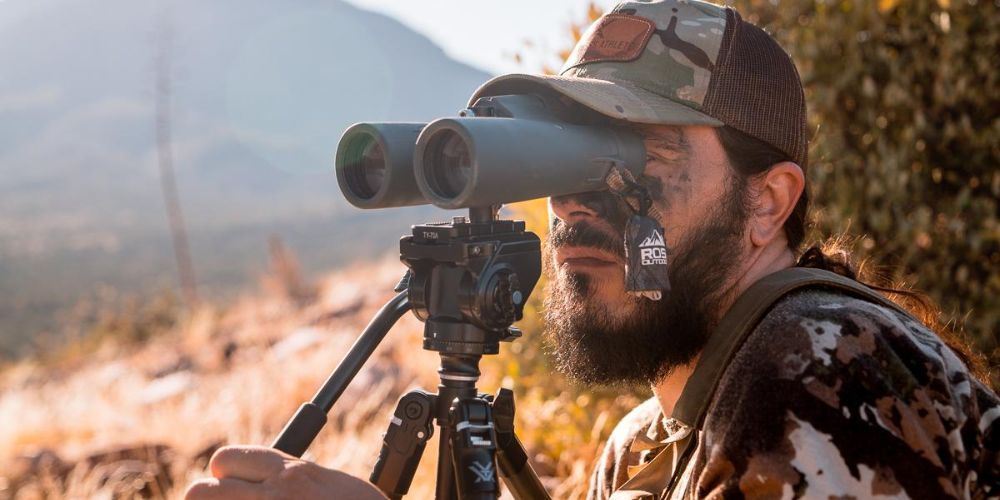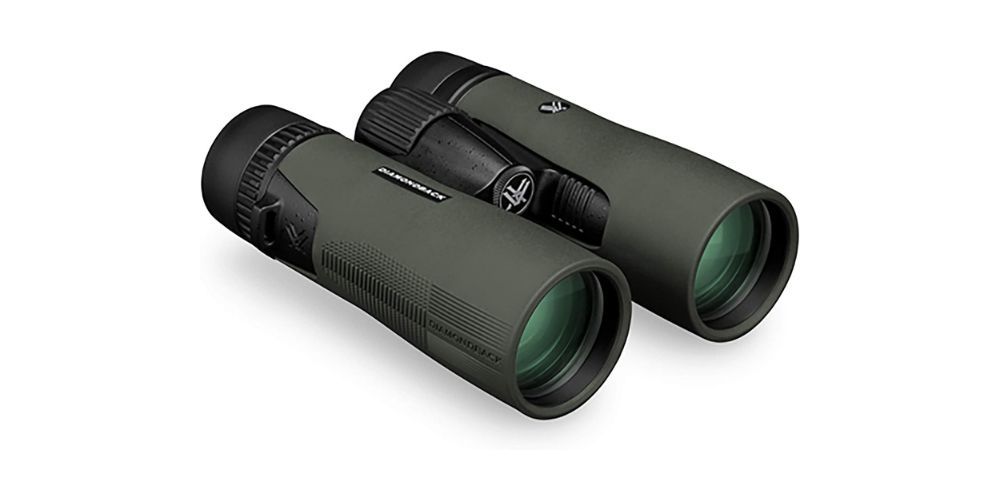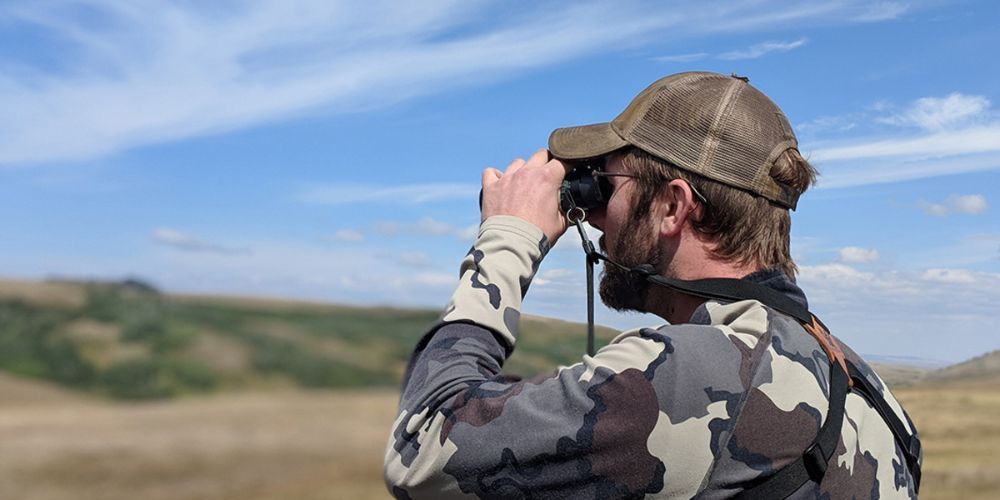Hunting Binoculars: The Best Optics for Wildlife Tracking
July 22, 2024
The best binoculars for hunting are those that offer clear, magnified views of distant objects. They are effective tools that significantly improve your ability to spot and identify animals from afar. However, what many fail to consider is how vital these devices can be in ensuring a safe hunting trip - they not only help you observe animals, but also allow you to avoid potential hazards or dangerous animals. Speaking of spotting, let's dive into details on choosing the ideal pair for your needs.
The
Vortex Triumph HD 10x42 binoculars are highly recommended for hunting due to their excellent optical performance, durability, and value. With superior resolution and low-light performance, these binoculars provide hunters with a clear, bright image in various lighting conditions.

What are Binoculars for Hunting?
Imagine yourself in the heart of nature, eagerly observing the various wildlife species from a distance, trying to spot their movements and behaviors without scaring them off. This is where hunting binoculars become an indispensable companion in your outdoor expeditions. These optical devices work like magic, magnifying distant objects and animals with precision and clarity.
Firstly, it's important to understand how they function. Binoculars for hunting consist of two parallel telescopes aligned to point in the same direction. This configuration allows users to have a three-dimensional view and a wider field of vision, making it easier to detect animals moving through dense vegetation or across open landscapes.
Consider this: When you're scanning the horizon, looking out for deer trails or elk herds, your binoculars become your closest ally in identifying distant game without alerting them to your presence.
Moreover, the magnification capabilities play a significant role in wildlife observation. The average magnification range for hunting binoculars falls between 8x and 12x, providing users with a clear, close-up view of distant subjects. Imagine being able to watch a majestic eagle perched on a high tree branch as if it were just a few feet away. That's the kind of powerful visual enhancement that hunting binoculars offer hunters.
Let's say you're out tracking game and you come across a potential target several hundred yards away. With the right pair of hunting binoculars, you can zoom in on the animal's features and behavior with amazing clarity, aiding in quick and accurate identification while maintaining a safe distance.
Key Features to Look For:
- Objective Lens Diameter - 42mm to 50mm
- Field of View at 1,000 Yards - 300ft to 400ft
- Eye Relief - 14mm to 20mm
- Weight - 25oz to 40oz
Hunting binoculars are invaluable tools for wildlife enthusiasts. Their unique design and enhanced magnification capabilities provide hunters with the added advantage of effectively observing their surroundings while respecting the serenity of nature.
With a clear understanding of what makes hunting binoculars essential, let's now turn our focus to picking the ideal optics tailored specifically to your needs.
Picking the Ideal Hunting Binoculars
Choosing the right pair of hunting binoculars can be a game changer for your wildlife tracking journey. So, let's break it down and make it easier for you.
Determine Budget and Specifications
First things first, you need to decide on a budget. It's okay to start small with something that fits your wallet comfortably. Consider your specific needs too - how far will you be spotting? Different types of hunts require different features in binoculars. If it's open country or mountainous terrain, you'll likely want a higher power magnification. But if it's dense woodland, a lower power but wider field of view might be more beneficial.
What to Remember
- For open-field hunting: Higher magnification and narrower field of view might be necessary.
- For bird watching: A wider field of view may be more important.
- For woodland hunting: A balance between magnification and field of view is essential.
Now let’s talk about the lens diameter - larger lenses allow more light in, which is beneficial for low-light conditions, but they also make the binoculars bigger and heavier. A compromise for someone who takes part in various types of hunts is mid-size binoculars with 32mm objective lenses.
Research Trusted Brands
Next up is finding the right brand. You'll come across a lot of options out there, but it's important to stick with reputable brands known for producing high-quality hunting binoculars. Brands like Zeiss, Vortex, Maven, and Swarovski have been known for their durable construction and excellent optical performance. While these may come at a premium, quality isn't something to skimp on when it comes to optics that are crucial for your outdoor pursuits.
Here's what You Can Expect from Trusted Brands
- High-quality materials that offer durability and longevity.
- Advanced optical technology including special lens coatings and tough rubber exteriors designed specifically for hunters.
Investing in trusted brands ensures that you're getting precision instruments that will hold up to the rigors of regular outdoor use while providing the visual acuity required for successful wildlife tracking experiences.
By focusing on these key considerations - budget, specifications, and trusted brands - you'll be well on your way to finding the perfect pair of hunting binoculars for your outdoor adventures.
As we turn our attention towards exploring size and weight considerations for hunting binoculars, we approach an aspect of equal importance in enhancing your wildlife tracking experiences.
Size and Weight Considerations for Hunting Binoculars
When you're out in the wild tracking sturdy game or hidden wildlife, every ounce and inch of space counts. That's why considering the size and weight of your hunting binoculars is crucial.
You don't want your binoculars to be a burden while you're trekking through rugged terrain or patiently waiting for that decisive target. Compact and lightweight binoculars are not only easier to carry but also fatigue you less over time. It's all about finding the right balance between magnification power, field of view, and the least amount of bulk.
Imagine yourself out in the woods, walking for hours at a stretch with your binoculars – extra weight could easily add up and become tiresome. Compact binoculars free you from unnecessary heaviness, while still providing a clear view. They are life-savers on long hunting trips as they don't wear you out too quickly.
Here’s something to consider: A 10x42-size binocular means that the object will appear 10 times closer than it would to your unassisted eye, with a 42 mm objective lens diameter providing a good balance between portability and light-gathering potential.
Think of it like carrying a water bottle on a hike; when you pick one that's too heavy or bulky, it becomes more of an annoyance than a convenience.
So, when choosing your pair of hunting binoculars, always prioritize compactness and ideally aim for a weight range around 1.2 to 1.6 lbs. This would allow you to maintain focus and surveillance without compromising on the convenience factor.
Considering these factors ensures that your hunting binoculars are not just an essential tool for tracking wildlife but also a comfortable companion on extended outdoor excursions.
Ensuring optimal size and weight is just the beginning. Now, let's explore how zoom capabilities and field of view play a pivotal role in making the right choice of hunting binoculars.
Zoom and Field of View in Hunting Binoculars
When you're out hunting, it's not just about seeing far - it's also about seeing wide. Magnification is important, but so is the field of view. Let's break down these concepts to understand why they matter.
Magnification, or how much closer the object appears through the lens, is usually the first thing people think about when choosing binoculars. But here's the deal: high magnification means you can see far, but it narrows your field of view. On the other hand, lower magnification provides a wider field of view.
When tracking an animal on the move or keeping an eye on a whole herd or flock, a wide field of view lets you see more at once, making it easier to locate wildlife and follow them as they move around. This is especially useful when observing groups or scanning open areas for wildlife.
For instance, imagine using high-magnification binoculars while birdwatching. You spot a bird in flight and want to follow its path through the sky. With a narrow field of view due to high magnification, you might find it challenging to keep track of the bird as it moves because there's only a small area visible through the lenses at any given moment.
Now, picture yourself in the woods, trying to spot wildlife in their natural habitat—a wide field of view would allow you to observe more of your surroundings, increasing your chances of spotting animals even if they are moving quickly. So when looking for hunting binoculars, remember that while high magnification may seem appealing, a wider field of view can be just as if not more important for effectively observing wildlife in action.
Now let's examine how these considerations come into play in real-world hunting situations.

Importance of Coating and Optics Quality
Imagine looking through your hunting binoculars only to find that the image is dull and lacks clarity. Lens coatings and optics quality can make a world of difference when it comes to the visual experience.
Lens Coatings
Lens coatings are integral to the performance of hunting binoculars. Multi-coated or fully multi-coated lenses are essential for reducing glare and optimizing light transmission, resulting in clear and bright images, especially in low-light conditions during dawn and dusk. This allows hunters to observe wildlife with precision, even in challenging lighting situations.
When out in the forest during twilight, the fading light makes it difficult to spot animals. Multi-coated lenses can significantly improve image brightness and contrast, enabling you to discern subtle details that could easily go unnoticed with uncoated lenses. By reducing glare and enhancing light transmission, these coatings ensure that you have a clear view, even when the lighting isn't ideal.
Prism Types
In addition to lens coatings, prism types also profoundly impact the performance of hunting binoculars. Consider binoculars equipped with phase-corrected roof prisms or dielectric-coated prisms. These advanced prism technologies enhance image resolution and color accuracy, enabling hunters to spot and identify animals with precision.
Prisms play a crucial role in ensuring that the image projected through the binoculars is sharp, clear, and accurately represents the colors of the natural world. These advanced prism types provide a distinct advantage by delivering superior image quality, allowing hunters to observe and assess their surroundings with unparalleled clarity.
By investing in hunting binoculars that incorporate these high-quality lens coatings and advanced prism technologies, hunters can significantly elevate their wildlife tracking experience. The crisp, vibrant images produced by such optics not only enhance visibility but also contribute to improved accuracy in wildlife identification.
The lens coatings and prism types in hunting binoculars are more than just technical specifications—they directly impact your ability to observe wildlife with clarity and precision, ensuring that every detail is vividly captured and allowing for a more immersive hunting experience.

Optimizing Binoculars for the Best Performance
Having top-notch binoculars is half the battle won, but only if you use them to their full potential. Here's how to squeeze every drop of visual excellence out of your hunting binoculars.
Proper Adjustment
Properly adjusting your binoculars is crucial for a comfortable and effective viewing experience. It reduces eye strain and ensures that both lenses are perfectly aligned with your eyes. This step can make a world of difference, especially during long outdoor activities such as wildlife tracking or birdwatching. Start by adjusting the eyecups to the correct position, allowing your eyes to align with the binocular's eyepieces comfortably. Make sure to calibrate the focus according to your vision, ensuring that the images are crisp and clear. By taking the time to set up your binoculars properly, you'll be rewarded with a more enjoyable and immersive viewing experience without any discomfort or blurriness.
Use with Other Gear
Pairing your binoculars with a sturdy tripod can significantly enhance their performance, especially when observing distant subjects for extended periods. A tripod provides stability and reduces hand fatigue, allowing you to maintain a steady view without straining your arms. This becomes incredibly useful when tracking fast-moving wildlife or when focusing on faraway objects for prolonged periods. Additionally, using a tripod frees up your hands, allowing you to take notes, adjust other gear, or simply stay in a comfortable position while still maintaining a clear view through your binoculars.
It's like having an extra set of steady hands to support your invaluable hunting companion.
By making these simple adjustments and utilizing additional gear, you can truly optimize the performance of your binoculars, ensuring a superior and comfortable viewing experience that will elevate your wildlife tracking adventures.
Practical Use of Hunting Binoculars
Just picture yourself out in the woods on a crisp morning, eagerly waiting for wildlife to appear. While being in nature is rewarding, there's something truly special about observing the beauty of wildlife in their natural habitat. This is where your hunting binoculars become an indispensable tool.
One of the most valuable uses of hunting binoculars is scanning the environment with precision. Instead of straining your eyes to catch a glimpse of distant movement, which might end up being nothing more than a trick of the light, binoculars provide a crystal-clear view of the wildlife. By focusing on areas known for wildlife activity, such as game trails, watering holes, or open fields, you increase your chances of spotting animals before they spot you.
Imagine this: You're standing atop a hill, and with your binoculars, you notice a faint movement near an evergreen grove. As you zoom in, a magnificent buck comes into view—an enthralling sight you wouldn't have been able to discern without binoculars.
In addition to pinpointing potential game, hunters also use binoculars to identify detailed features that may impact their decision-making in the field. Assessing factors such as the animal's size, age, and gender allows for informed and ethical hunting practices. Before taking any action, it's crucial to adhere to hunting regulations by ensuring that the target meets all legal requirements. This extra layer of evaluation not only ensures compliance but also promotes responsible and sustainable hunting practices.
Binoculars help hunters identify potential game, assess their size, age, and gender, and determine if they meet hunting regulations before taking any further action.
With these practical applications in mind, it's evident that utilizing hunting binoculars enhances both the efficiency and ethical aspects of wildlife tracking.
The use of hunting binoculars not only aids in spotting wildlife but also contributes to responsible and sustainable hunting practices, enriching the experience for nature enthusiasts everywhere.
What features should I look for in hunting binoculars?
Describe the item or answer the question so that site visitors who are interested get more information. You can emphasize this text with bullets, italics or bold, and When selecting hunting binoculars, several key features can enhance your wildlife tracking experience. Firstly, consider the magnification and objective lens size. A common recommendation is 8x42 or 10x42, where 8x or 10x represents the magnification power, and 42mm is the objective lens diameter. This combination provides a good balance of magnification and field of view, essential for spotting and tracking animals. Additionally, look for binoculars with high-quality lens coatings, such as fully multi-coated lenses, which improve light transmission and reduce glare, resulting in clearer and brighter images. Waterproof and fog-proof construction is crucial for use in various weather conditions. Finally, consider the weight and ergonomics of the binoculars, as you’ll likely be carrying them for extended periods. links.
How do I properly use and maintain my hunting binoculars?
Proper use and maintenance of your hunting binoculars ensure their longevity and optimal performance. To use them effectively, start by adjusting the eyecups to match your eye relief, which is particularly important if you wear glasses. Next, set the interpupillary distance by moving the barrels closer or farther apart to match the distance between your eyes. Use the central focus wheel to get a sharp image in both eyes, and then use the diopter adjustment to fine-tune the focus for one eye, compensating for any differences in your vision. For maintenance, keep the lenses clean using a soft brush or air blower to remove debris, followed by a microfiber cloth to clean the lenses gently. Avoid touching the lenses with your fingers and store the binoculars in a protective case when not in use. Regularly check for any signs of damage or wear and address them promptly to keep your binoculars in top condition.
What are the benefits of using binoculars for wildlife tracking compared to other optics?
Using binoculars for wildlife tracking offers several advantages over other optics, such as spotting scopes or monoculars. Binoculars provide a wider field of view, which is beneficial for scanning large areas and quickly locating animals. This broader view also makes it easier to track moving targets without losing sight of them. Binoculars are generally more portable and easier to use on the go compared to spotting scopes, which often require a tripod for stability. Additionally, binoculars provide a more comfortable viewing experience by allowing both eyes to be used, reducing eye strain during prolonged use. Their versatility makes binoculars suitable for various hunting scenarios, from dense forests to open fields, making them an essential tool for any wildlife tracker.
Author: William Flaiz










